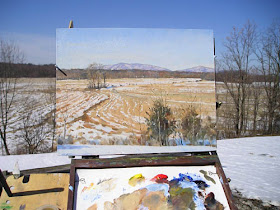An art student recently asked me the following question:
Dear James,
Some discussions I've been involved with lately have got me thinking about the relationship between color and value. Do you approach them as two different steps of a painting? For example some people see a well worked out monochromatic grisaille painting as perhaps the most important step in a painting, with the scumbled on color as an accentuating element. On the other hand some people have a more Alla Prima approach where they jump right into color, and create the illusion of "turning" surfaces and value directly through color mixing. How long do you spend on the monochromatic stage of a painting?
---Pro Cedure.

Dear Pro Cedure,
You ask a very great question color and value. Yes, I do think about the value structure as a separate step in developing a studio composition. I tend to do that thinking as a preliminary step in the charcoal or pencil stage. As I'm sure you know, Norman Rockwell was the king of planning the value design first in charcoal before jumping into oil (above: "The Ferry Story" courtesy of Heritage auctions).
Whether you plan the tonal structure as a separate study (as Rockwell, Cornwell, Lovell and many academics did) or whether you establish it on the final canvas as a preliminary stage of painting, either way it really is the foundation of a good picture. Color adds a lot, but it can’t save a bad value design.
And even with a thorough planning, you can still turn forms with color temperature as you suggested in your question. Rockwell is a good artist to study for that, and I believe many of his instincts for impressionistic color effects came from his study with
Charles Hawthorne.
In my case with a fantasy or historical painting, once I have figured out the tonal design in two or three values as a separate step, I begin the layin or block-in. I don’t use a monochromatic grisaille but rather a limited palette of color, such as yellow ochre, burnt sienna, and ultramarine blue. The whole step should only take an hour or two.
My goal in the preliminary block-in is to establish not only the tonal statement, but also the big warm and cool relationships and the overall color mood at the very outset of the painting process. I stay well short of darkest darks, saving those for the finishing steps of the painting.
When working on location, or when painting the figure in under two hours, I am under shorter time requirements. So I often dive right in with color, but sometimes I do a quick pencil thumbnail sketch to plan the value design.
All the best, JG
----------
Related post on GJ:
The "two-streams" hypothesis of visual perception
Recommended books:
"Hawthorne on Painting"
"Rockwell on Rockwell"
I also cover this material in
"Imaginative Realism"


















































